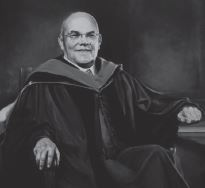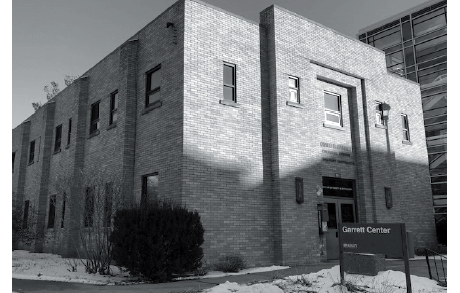
SID RUCKRIEGEL
Looking at the 900 block of State Street, it is hard to imagine a street of houses. But if you could go back a few years, one would see just that including the home of Romeo and Naomi Garrett. The grandson of former enslaved persons, Romeo had been born in 1910 near Natchez, Mississippi. After completing the few educational opportunities locally available for him, Garrett would make his way to New Orleans, taking a job as a porter to put himself through Straight College. Graduating with a B.A., he became a social worker and was educational supervisor with the Work Progress Administration where he made noticeable improvements in education and decreasing illiteracy.

Romeo B. Garrett (Photo Supplied by Bradley University)
With the outbreak of the World War II, Garrett enlisted in the then still segregated U.S. Army. Completing his enlistment with honors, Garrett moved to Peoria and married Naomi Sanders whom he had known in New Orleans. He enrolled at Bradley University. Studying sociology, he was the first African-American to receive his master’s degree from Bradley and, upon graduation in 1947, was immediately offered a position on the faculty.
In the 1950s, he and Naomi would move a few blocks away from their first Peoria address at 902 State St. to a 2 1/2 story Victorian (304 7th St.) complete with a two story front porch. Both this house, and the State Street home, were just a few blocks from the Zion Baptist Church were he served as associate pastor. This residence would be their home until the city would tear down the neighborhood he loved under the auspices of urban redevelopment.
As a professor at Bradley, Garrett would earn additional degrees and write numerous books, including on the history of the black experience in Peoria. He was active his entire life in civil rights, both off campus and on, including for the on-campus housing for minority students and hiring more minority professors among many other important initiatives.
In 1964, the Romeo B. Garrett Scholarship was endowed, having to date impacted more than 400 students. Among his many honors, Garrett was named professor emeritus upon retiring in 1976; two years later the Second Christian Science Reading Room, 924 Duryea, was purchased by Bradley University and named as the Garrett Cultural Center Auditorium.

Garrett Cultural Center Auditorium, 924 Duryea Place (Photo by Sid Ruckriegel)
The auditorium is a pale tan brick two-story building built in the pre-war minimalism style. The heavy structural mass is communicated through small punctuations of windows while a heavily stylized, but not ornate, detail surrounds the front door, topping the entrance with a second-story brick frieze. The plain sidewalls are interrupted by a series of stylized buttresses. The first floor houses an auditorium space (originally the reading room) while the second floor is divided into smaller spaces, providing educational and social spaces for students.
In later years, Romeo B. Garrett would come back to Southtown and build a new home, one of the few displaced who would return. Houses are sometimes identifiable with the occupants who once lived there; maybe, though, the expanse of Garrett’s work and experiences are too impactful and need something more than just a house. Perhaps the Garrett Auditorium, standing as a solid living legacy, is a better way to remember the tireless work he did not only for Peoria but our entire community and to challenge us to continue the work still to be done.

1 comment for “Bricks & Mortar: Garrett Cultural Center Auditorium”
Recent Comments
Wonderful story & tribute